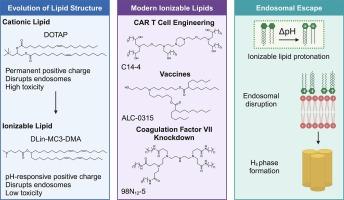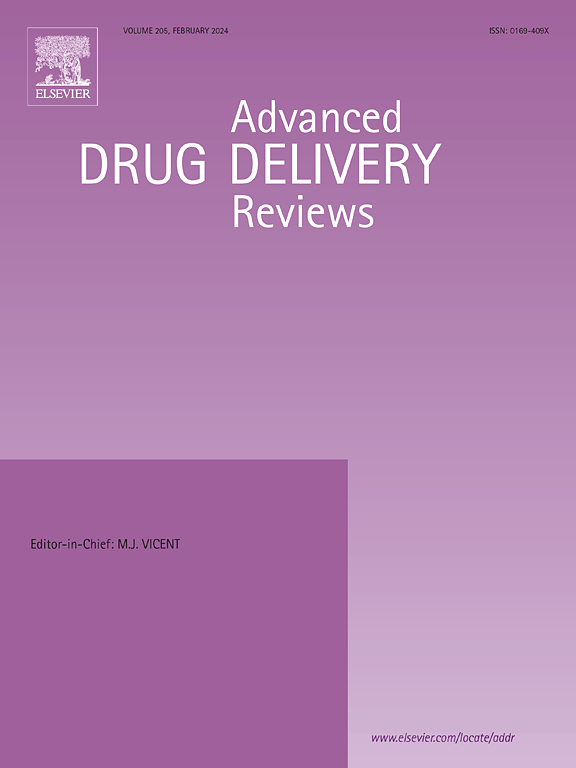Breaking the final barrier: Evolution of cationic and ionizable lipid structure in lipid nanoparticles to escape the endosome
IF 17.6
1区 医学
Q1 PHARMACOLOGY & PHARMACY
引用次数: 0
Abstract
In the past decade, nucleic acid therapies have seen a boon in development and clinical translation largely due to advances in nanotechnology that have enabled their safe and targeted delivery. Nanoparticles can protect nucleic acids from degradation by serum enzymes and can facilitate entry into cells. Still, achieving endosomal escape to allow nucleic acids to enter the cytoplasm has remained a significant barrier, where less than 5% of nanoparticles within the endo-lysosomal pathway are able to transfer their cargo to the cytosol. Lipid-based drug delivery vehicles, particularly lipid nanoparticles (LNPs), have been optimized to achieve potent endosomal escape, and thus have been the vector of choice in the clinic as demonstrated by their utilization in the COVID-19 mRNA vaccines. The success of LNPs is in large part due to the rational design of lipids that can specifically overcome endosomal barriers. In this review, we chart the evolution of lipid structure from cationic lipids to ionizable lipids, focusing on structure–function relationships, with a focus on how they relate to endosomal escape. Additionally, we examine recent advancements in ionizable lipid structure as well as discuss the future of lipid design.

打破最后的障碍:脂质纳米颗粒中阳离子和可电离脂质结构的演变,以逃离内质体。
在过去的十年中,核酸疗法在开发和临床转化方面取得了长足的进步,这主要归功于纳米技术的进步,它使核酸的安全和靶向运输成为可能。纳米颗粒可以保护核酸不被血清酶降解,并能促进核酸进入细胞。不过,实现内溶酶体逸出以允许核酸进入细胞质仍然是一个重大障碍,只有不到 5%的内溶酶体途径颗粒能够将其货物转移到细胞质中。基于脂质的药物递送载体,尤其是脂质纳米颗粒(LNPs),已经过优化,可以实现有效的内溶酶体逃逸,因此成为临床上的首选载体,COVID-19 mRNA 疫苗中的使用就证明了这一点。LNPs 的成功在很大程度上归功于能特异性突破内体屏障的脂质的合理设计。在这篇综述中,我们描绘了从阳离子脂质到可电离脂质的脂质结构演变过程,重点介绍了结构与功能的关系,尤其是与内质体逃逸的关系。此外,我们还研究了可电离脂质结构的最新进展,并讨论了脂质设计的未来。
本文章由计算机程序翻译,如有差异,请以英文原文为准。
求助全文
约1分钟内获得全文
求助全文
来源期刊
CiteScore
28.10
自引率
5.00%
发文量
294
审稿时长
15.1 weeks
期刊介绍:
The aim of the Journal is to provide a forum for the critical analysis of advanced drug and gene delivery systems and their applications in human and veterinary medicine. The Journal has a broad scope, covering the key issues for effective drug and gene delivery, from administration to site-specific delivery.
In general, the Journal publishes review articles in a Theme Issue format. Each Theme Issue provides a comprehensive and critical examination of current and emerging research on the design and development of advanced drug and gene delivery systems and their application to experimental and clinical therapeutics. The goal is to illustrate the pivotal role of a multidisciplinary approach to modern drug delivery, encompassing the application of sound biological and physicochemical principles to the engineering of drug delivery systems to meet the therapeutic need at hand. Importantly the Editorial Team of ADDR asks that the authors effectively window the extensive volume of literature, pick the important contributions and explain their importance, produce a forward looking identification of the challenges facing the field and produce a Conclusions section with expert recommendations to address the issues.

 求助内容:
求助内容: 应助结果提醒方式:
应助结果提醒方式:


